Although I love the real estate of my iPhone 6 Plus, one of my ongoing dilemmas has been deciding what applications to keep on my home screen. I dealt with the dilemma by creating a series of folders. I never liked this solution since it looks cluttered and necessitates several clicks to get to any app.I recently rediscovered Launcher. Launcher gives one-click access to my most commonly used apps. Launcher works by installing widgets on the Notification Page of iOS (accessible by pulling down the menu from the top from any page). Launcher lets me launch apps, build communication shortcuts, access web pages, and much much more.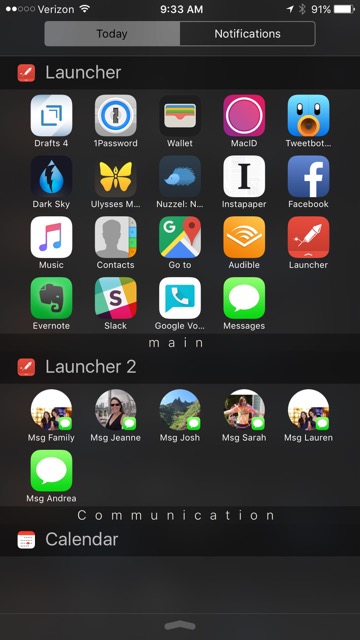 I’ve built widgets for my most commonly used apps, clinical apps and links, texting and calling my family, and travel. I can move these launchers in and out of my access bar depending on the situation. For instance when I'm traveling I move my travel widget higher on the Notifications Page.
I’ve built widgets for my most commonly used apps, clinical apps and links, texting and calling my family, and travel. I can move these launchers in and out of my access bar depending on the situation. For instance when I'm traveling I move my travel widget higher on the Notifications Page.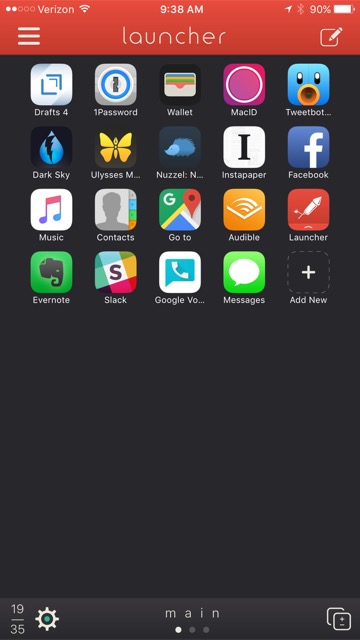
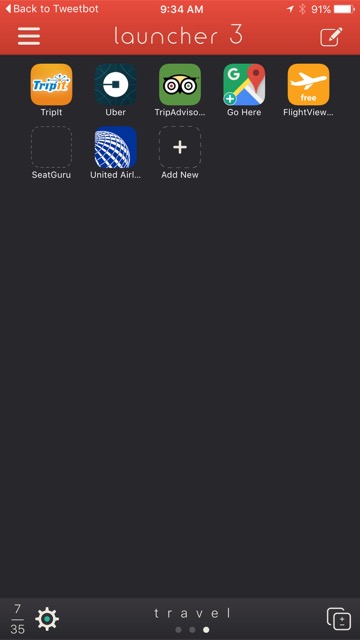 I found this application incredibly handy. It's changed the way I configure my home screen. Spending the $2.99 to unlock the Pro features is more than worth the price.
I found this application incredibly handy. It's changed the way I configure my home screen. Spending the $2.99 to unlock the Pro features is more than worth the price.
Capturing Clinical Questions Using Drafts and Evernote
Being a physician means a commitment to lifelong learning. In a busy clinical practice, two-thirds of clinical encounters generate at least one clinical question. In an average day the typical physician has at least 11 unanswered clinical questions. Only 40% of those questions ever get answered. Most of the questions are forgotten in the hustle and bustle of clinical care.In an attempt to improve my ability to capture (and answer) these questions, I've developed a new script for Drafts. This script uses the same concept as the technique I've mentioned to capture ideas, quotes, etc. This particular script saves information to Evernote but you could use Ulysses, DayOne, Wunderlist, or any other app you can program with an action. I chose Evernote since Evernote has the ability to find related notes anywhere in my collection. When researcing answers my question I capture those to Evernote as well-linking the question and answers in my Evernote database in perpetuity. Since Evernote is ubiquitous, the answer is available on my computer iPhone, and iPad.Here is how I approached this. First, I set up a new notebook in Evernote. I called this notebook "Clinical Questions." I then developed the following script in Drafts. Using this script it is now possible for me to quickly capture questions investigate later. I merely open Drafts and type or dictate my question, then hit the script. The question is logged to my Clinical Questions Notebook (along with date and prepended with tag ClinicalQuestionX).I’ve found myself using this script many times each day. I hope it helps you as well.Stats found on UptoDate: http://goo.gl/BDBqmH
Using this script it is now possible for me to quickly capture questions investigate later. I merely open Drafts and type or dictate my question, then hit the script. The question is logged to my Clinical Questions Notebook (along with date and prepended with tag ClinicalQuestionX).I’ve found myself using this script many times each day. I hope it helps you as well.Stats found on UptoDate: http://goo.gl/BDBqmH
Ulysses Now Publishes Directly to Wordpress
Ulysses just keeps getting better. With the latest Ulysses release, you can publish directly to Wordpress (either wordpress.com or your own custom Wordpress site).
Scrivener iOS coming on July 20!
I have been quite impressed with the Scriver iOS Beta--it's capabilities far exceeded my expectations both on my iPhone and iPad. It has already simplified my Writing Workflow. I'm not alone in my exuberance. Check out this glowing review. The wait for The official release is almost over....the official date Is July 20 at a price of $19.99. There will be a simultaneous release of a new version of Scrivener for Mac.
Drafts Script to Capture Ideas to Ulysses
As I've mentioned in previous writing, I am a big fan of Ulysses. I now do all of my short writing in Ulysses, so I decided to transition my blog idea script from Drafts->Evernote to Drafts->Ulysses.The script prepends "BlogX" and the current date, erases the Drafts file, then places my new idea in my Ulysses Inbox.In Ulysses, I keep three blog related groups: Ideas, In Process, and Published. I no longer have to take time to move my ideas from Evernote to Ulysses. Instead, each idea is submitted to Ulysses, eliminating entirely the need for Evernote. If you use lUlysses, you can adopt this script for capturing other ideas as well. I hope you find it useful.
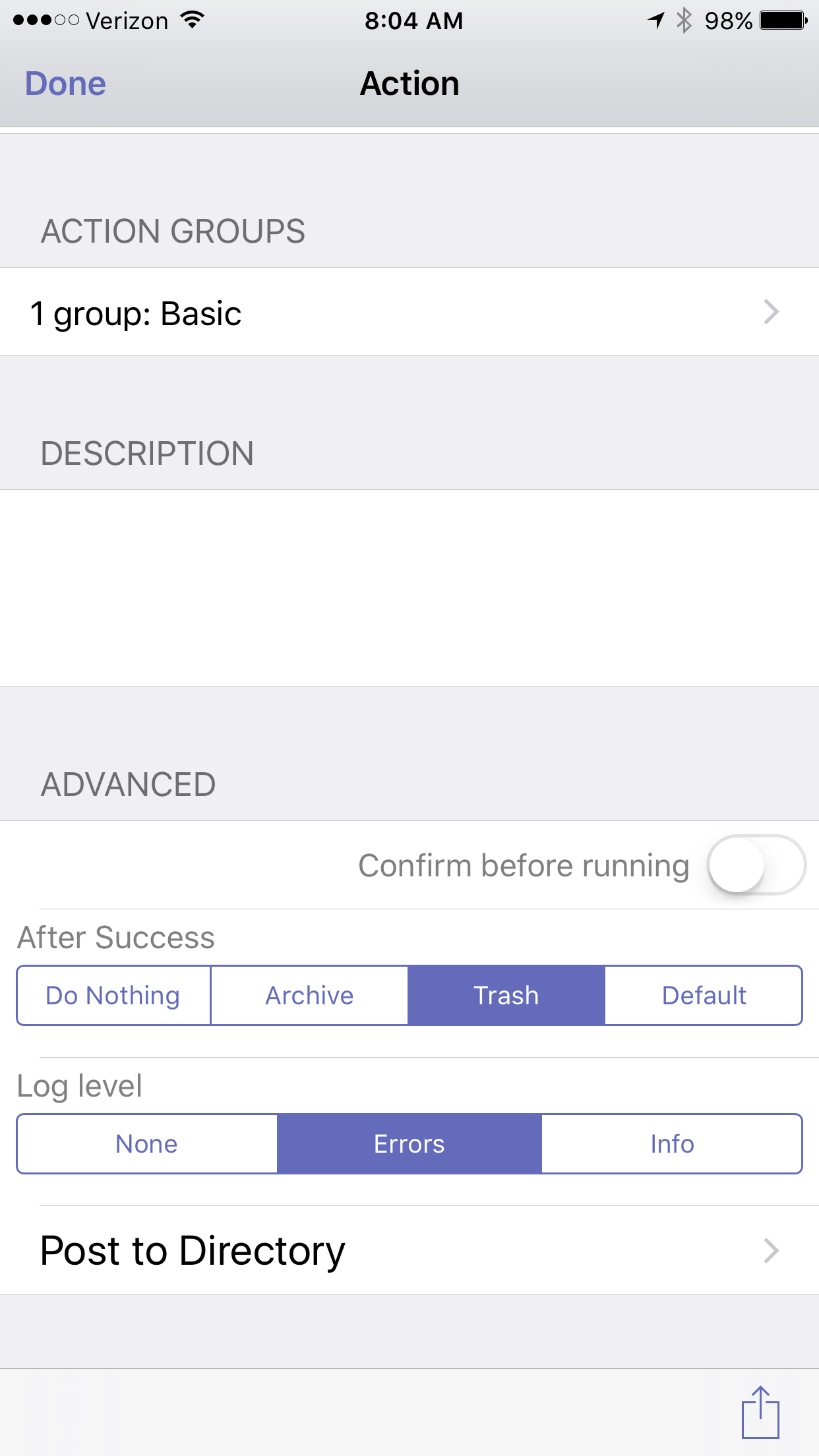
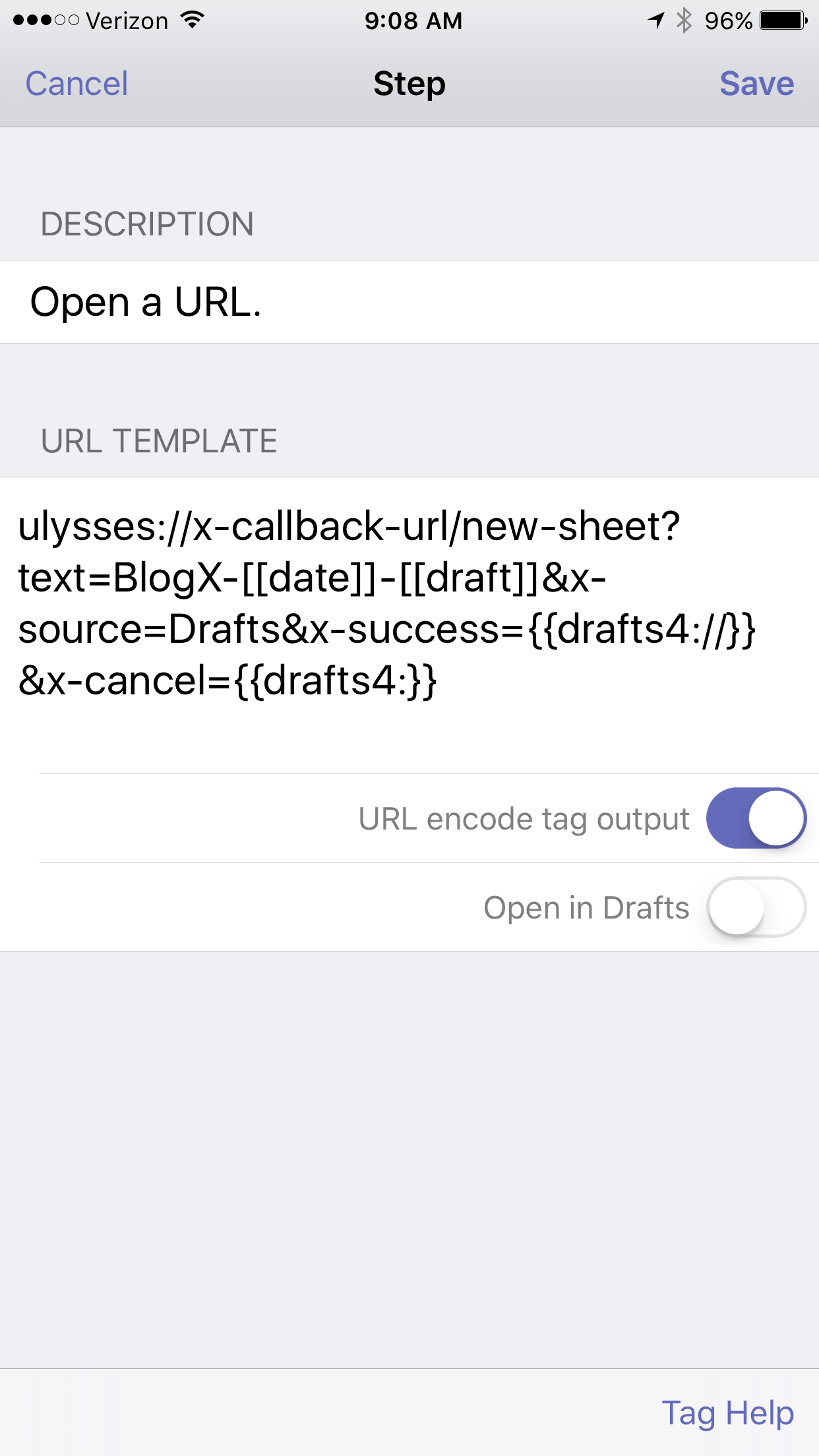
Writing Morning Pages with an iPad Pro
A couple of months ago, I was feeling the age of my first generation iPad Air and decided I needed to upgrade to an iPad Pro. I was torn between the larger 12.9 inch model and the smaller 9.2 inch model. Although I was attracted to the portability of the 9.2 inch version, in the end I bought the larger model. I decided to go with the larger model for a variety of reasons: 1. When reflecting on how I used my technology, I found when I had a task to do, I'd often forgo the iPad Air and just use my iPhone 6 Plus, 2. I wanted the best support for my extensive use of the Duet App (the larger screen giving me more portable dual screen real estate), 3. It was becoming increasingly difficult for me to read and annotate PDFs on the smaller screen.I purchased the iPad Pro (along with a Logitech keyboard and Apple Pencil) and have not looked back. One of my favorite unexpected uses of the iPad Pro is the ability to write with the Apple Pencil. In addition to Mindfulness and meditation, I am a true believer in the process of Morning Pages, a journaling technique that espouses the power of long-hand writing in the creative process. Up until the time I bought my iPad Pro, I was using a LiveScribe Pen to do my daily writing. No more!I have been experimenting with various writing apps including: GoodNotes, Penultimate, and Notability. Despite the more feature-rich environment of GoodNotes and the versatility of Notability, I find myself favoring Penultimate, primarily for its ease-of-use and automatic Evernote synchronization. I'd love to hear what your favorite handwriting app might be, and how you're using the handwriting capabilities of the new iPads.If you are not yet writing your own Morning Pages, I hope you'll give it a serious try.
New NIH Grant Requirements - Critical Evaluation of Existing Literature
For those of you that write NIH grants for a living, you are well aware of the changes required for new grant applications in 2016. In an effort to improve rigor and transparency as well as to increase reproducibility, The NIH now requires the grants to be written in a whole new way. A major part of these changes has to do with critical evaluation of existing literature.In light of these changes I have been formally appending my manuscripts a new way. In previous entries I’ve written how I take notes while reading, then extract these highlights and notes to their own individual files. Now, as I'm reading, I make and effort to record perceived strengths weaknesses of each study appending my comments with the text “StrengthX” or “WeaknessX.” I then extract each comment as its own text file. When writing grants or manuscripts, using Devonthink, I’m able to find similar notes to the one I’m reading. By appending StrengthX or WeaknessX, I’m able to single out my own comments instead of a seeing every instance of each word.In a future entry, I’ll talk more about the ways I’ve updated finding extracted information using Devonthink (and Tinderbox). A good portion of my writing workflow from 2015 has changed. I will write an updated writing workflow after the official release of Scrivener iOS.I'd be interested to hear how other academics are dealing with the changes at the NIH. Please leave a note in the comments below.
Free Time 2 - scheduling made easy!
Meetings are unavoidable in academics. For busy professionals, finding a time to meet can be a daunting task. Although apps like Outlook have built in scheduling features, few use them. One major limitation; Outlook's scheduling features only work for individuals using the same corporate domain.Previously, I wrote about my love of Sunrise Meet--a fabulous add on to Sunrise that smoothed the task of scheduling meetings. Sunrise was purchased by Microsoft and, unfortunately, the app will soon be shuttered. Thus, I went on a quest to find a Sunrise Meet replacement. I'm happy to report I found great alternative: Free Time 2Free Time 2 is a standalone app for iOS. The interface is clean and intuitive. If I receive a meeting request, I merely open the app and surf to the potential day(s) of interest. Each day displays a list of appointments along with my free time. I select as many potential meeting times on as many days as I’d like to propose.
I select as many potential meeting times on as many days as I’d like to propose.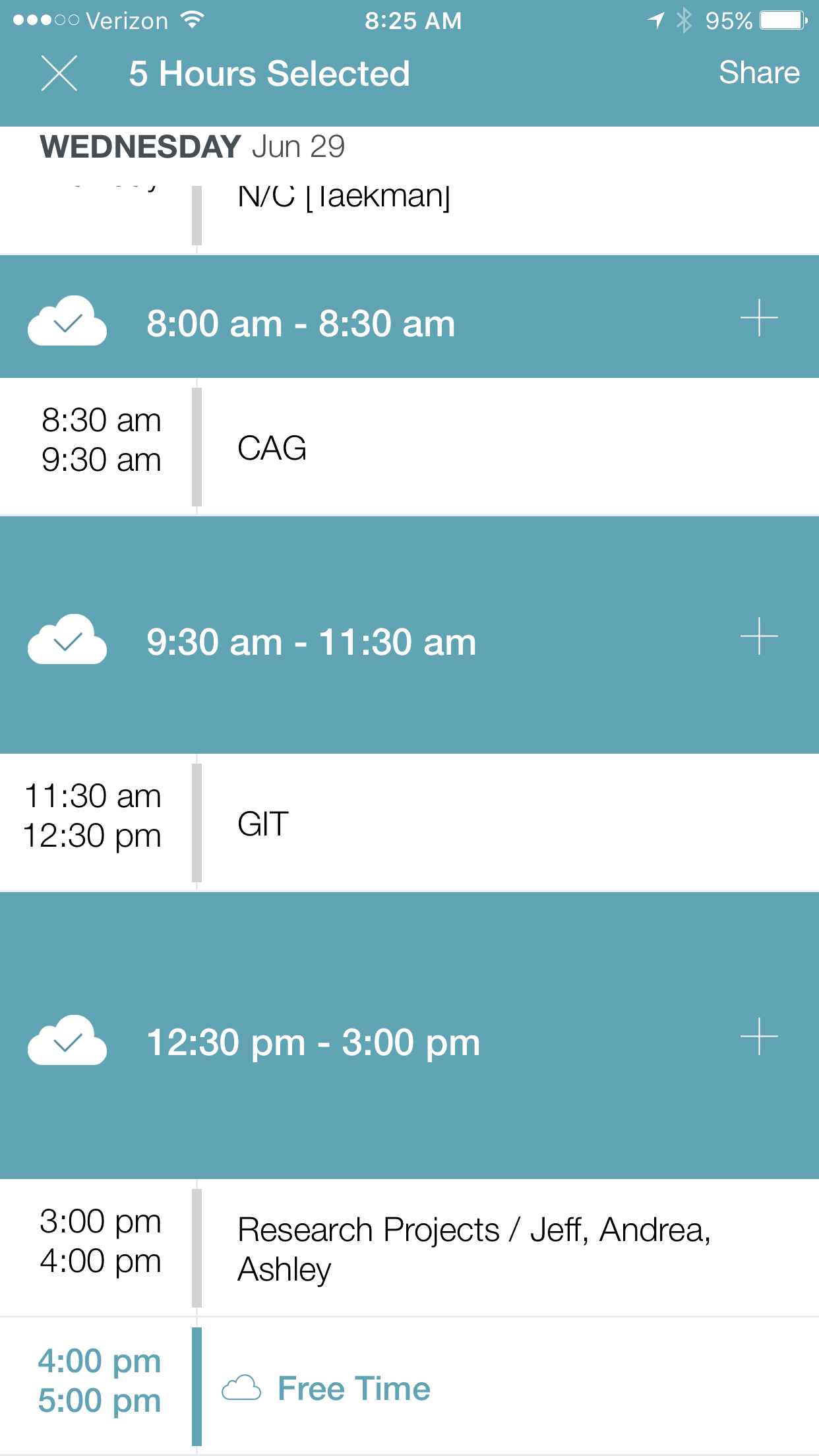 I then hit “Share,” opening the Action Menu.
I then hit “Share,” opening the Action Menu.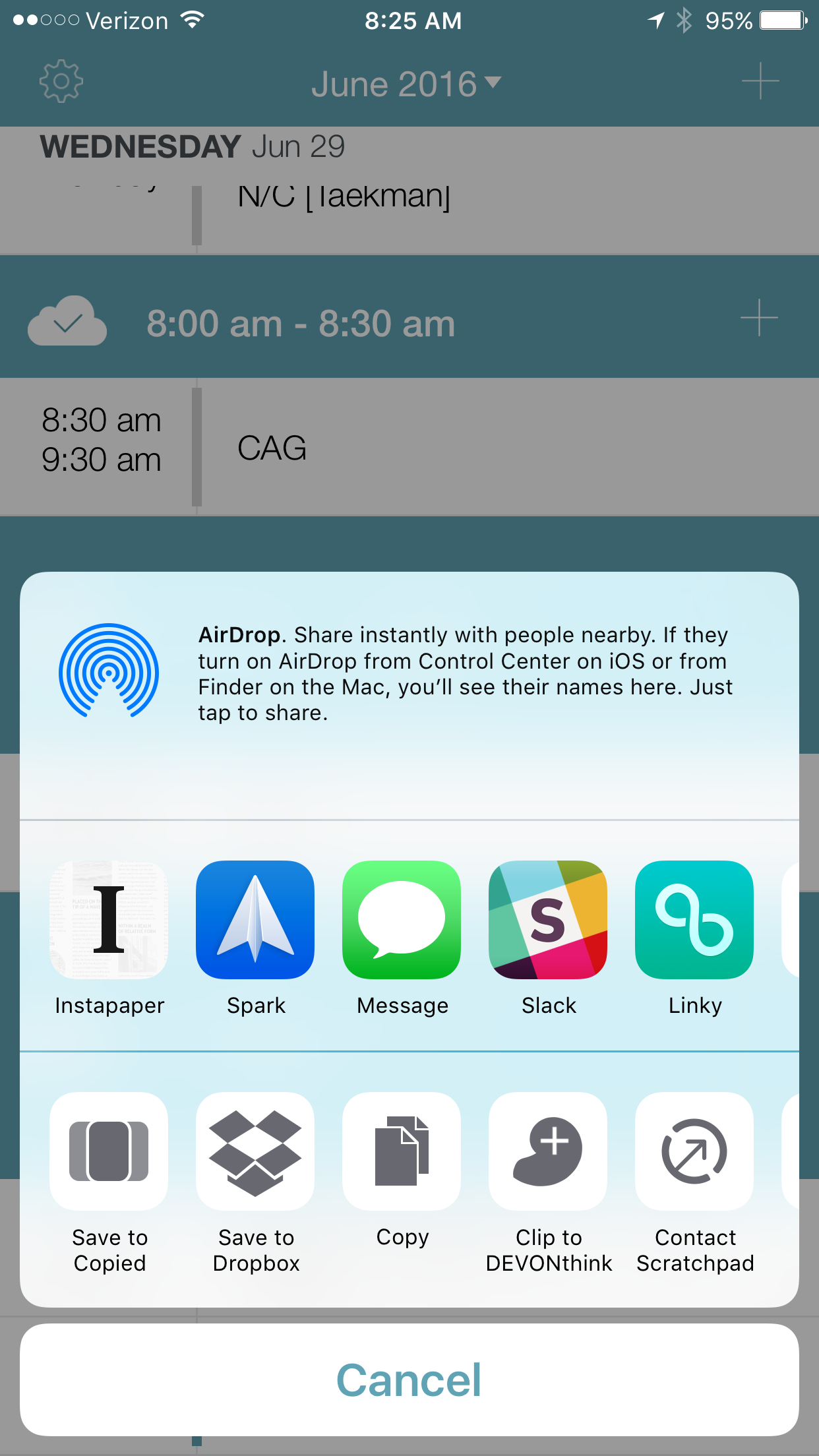 I choose what app I’d like to share my availability. Free Time formats the list of the potential dates for me. Here is an example in Spark.
I choose what app I’d like to share my availability. Free Time formats the list of the potential dates for me. Here is an example in Spark. Free Time 2, in many ways, outshines Sunrise Meet. I use Free Time several times each day to schedule 1:1 meetings. Now if only there was an app that could seemlessly handle multi-person scheduling. Enjoy!
Free Time 2, in many ways, outshines Sunrise Meet. I use Free Time several times each day to schedule 1:1 meetings. Now if only there was an app that could seemlessly handle multi-person scheduling. Enjoy!
Spark by Readdle - my new email app
eMail is the bane of everyone's existence. Although I’ve been pretty diligent about reading email on the go, a problem I frequently faced was the issue of “skimmed emails”-those emails I read on the go but failed to immediately process. Later, when I returned to my Mac, I often missed the skimmed email because each appeared "read." Unfortunately, until recently, I had not found a suitable solution to this recurrent problem.I am a big fan of Macsparky. One of my favorite features on David Spark’s Web Site is the sharing of user’s home screens. In a recent post, I saw Brett Kelly (Website)(Twitter) mention Spark by Readdle and decided to give it a try. I have to say I’ve been incredibly impressed. Spark has completely replaced Mail.app on my phone and iPad. I can’t imagine going back.Spark is one of those apps that is a delight to use. The developers paid a great deal of attention to user-interface design. Even now, several weeks into my exploration, I continue to find subtle features that really do live up to Readdle's promise to have me “Like Your email Again."Spark has almost completely eliminated the Skimming problem on my phone. I now process 98% of my emails as I read them on the go. My Inbox has remained essentially empty since I started using the App.A few minor suggestions that could make the program even better: 1. the ability to add actions to swipes (ala Drafts) and 2. the addition of other gestures (taps?) that would further enhance the number of customizable processing options.Spark is now my iOS email client of choice. I hope you give it a try too.
Using Skitch and Papers to Capture Figures and Tables
Few would argue that the most important point of a scholarly manuscript is made in its figures and tables. I am going to share with you how I capture figures while reading scholarly information on my Mac. This workflow uses:SkitchPapersInstall Skitch and make sure, in Skitch Preferences, to enable the “keep Skitch Helper running in background when I quit,” and “Start Skitch Helper when I log in to my computer.” As I’m reading scholarly literature and come across a table or figure I want to save I do the following. I make the figure as big as possible on my screen. Then, from the Skitch menu in my menubar, I select the Crosshair Snapshot. I then select the figure (and sometimes the caption) trying to balance the white space surrounding the figure.Next, I go to Papers, select the reference in my Papers Library, and then from the Edit Menu:Copy As:Reference.I return to Skitch and double-click at the bottom of the figure then paste the reference text. I then balance the text. The height of the Skitch figure will expand to accomodate the new text.
As I’m reading scholarly literature and come across a table or figure I want to save I do the following. I make the figure as big as possible on my screen. Then, from the Skitch menu in my menubar, I select the Crosshair Snapshot. I then select the figure (and sometimes the caption) trying to balance the white space surrounding the figure.Next, I go to Papers, select the reference in my Papers Library, and then from the Edit Menu:Copy As:Reference.I return to Skitch and double-click at the bottom of the figure then paste the reference text. I then balance the text. The height of the Skitch figure will expand to accomodate the new text. When I want to refer to or use the table or figure I view it directly in Skitch or find it in Evernote. Using this method, I can also search for words in the reference (e.g. the author’s name or the title of the manuscript) and sometimes even the words in the figure itself.If I want to use the figure in a presentation or to send it to a colleague or trainee I can export the figure from the Skitch File Menu.Using this method I’ve captured hundreds of figures. I hope this workflow helps you too.
When I want to refer to or use the table or figure I view it directly in Skitch or find it in Evernote. Using this method, I can also search for words in the reference (e.g. the author’s name or the title of the manuscript) and sometimes even the words in the figure itself.If I want to use the figure in a presentation or to send it to a colleague or trainee I can export the figure from the Skitch File Menu.Using this method I’ve captured hundreds of figures. I hope this workflow helps you too.
Google GBoard - Love it!
I have become a big fan of the new Google keyboard, Gboard. I've been using this keyboard for IOS over the last week. During that time, Gboard has become my keyboard of choice supplanting the native Apple keyboard. I particularly like the ability to glide type and the ability to look up information on Google without leaving the current application. I’ve found emoji links, GIFs, and image links less useful.The only three drawbacks I have found include:1.losing the ability to dictate, 2. losing the ability to enter passwords, and 3. the fact that GBoard does not understand Apple Keyboard Shortcuts.For more information check out the Cult ot Mac article. Download Gboard and give it a try. I think you'll be pleasantly surprised.
Macsparky Video Field Guide on Hazel 4
My friend David Sparks has released a new video field guide--this time on Hazel. In true Macsparky fashion, he's delivered yet another outstanding resource. Even though I'm a seasoned Hazel user, I learned quite a few new tips and tricks--especially pertaining to the recently released Hazel 4. Pick up your copy of this and other excellent resources on the Macsparky website...and Hazel-on!
Lifehacker Review of Ulysses.app
Thorin Klosowski wrote a great review of Ulysses App on Lifehacker. Check it out.
The Sun Sets on Sunrise.app--iOS Calendars
One of the most-used application on my iPhone is my calendar. For quite some time, Sunrise has been my go-to app. About a year ago, Sunrise was purchased by Microsoft. This week, Microsoft has decided to kill the app. With the announcement that Sunrise will be inactivated in August, I started a search for an iOS calendar replacement. Although Sunrise appears to now be baked into Outlook for iOS, my workplace doesn’t allow me to use the app to access my Outlook account. I’m going to sorely miss Sunrise’s integration with LinkedIn and especially, the Sunrise Meet feature, that I use frequently.I am trying two calendars as replacements: Cal by Any.do and Fantastical 2. Neither seems perfect, but I’m leaning toward Cal for its clean design. I’ve never been fond of Fantastical’s user interface and I’m always a sucker for good design.I’ll keep you posted on what I find. If you have a particular go-to calendar app, I’d love to hear what you use, and why you like it.
MacWorld Review - Ulysses for iPhone
Macworld has a glowing review for Ulysses for iPhone in the May 2016 issue. I agree with the review, the app dwarfs all other writing programs on iOS. Check out the article and check out the app here.
My OmniFocus Set-up (Part 2)
As i've mentioned numerous times before, I'm a huge fan of OmniFocus. In my last entry on OmniFocus, I offered a peek into the way I organize my folders. If you haven't read that post, please do so now. In this entry, I’ll answer some of the questions about triaging, prioritizing, and adding time to actions.Weekly ReviewI am not strictly adherent to GTD methodology, but I do use many of the practices. My practice includes both daily and weekly reviews. My weekly review normally takes about an hour. During the hour, I review existing projects and actions, clean up remaining items in my Inbox, and set up new projects. I look at each new and existing project through two main lenses—a hard due date (e.g. tax filing-Covey Quadrant 1-CQ1), and the strategic importance of the project to my personal or professional life (Covey Quadrant 2-CQ2).As you saw in my last entry, all my projects are organized into folders by my personal and professional roles. During my weekly review I decide on the CQ1 and CQ2 projects with greatest strategic value, or with the most urgent deadlines. These are the projects that go into my “Weekly Priorities” Folder. My next most important strategic projects go into my “On-Deck” Folder. I try to have no more than three projects in each the weekly priority and the on deck folders. Those projects that are lower priority at the end of the week, but still active, go back into my personal or professional “Role” Folders. I spend about 80% of my time working on items in my Weekly Priority and On Deck folders. I have a custom perspective that filters all my projects down to my priorities grouped by project or context.
I spend about 80% of my time working on items in my Weekly Priority and On Deck folders. I have a custom perspective that filters all my projects down to my priorities grouped by project or context. Another perspective shows all my flagged or due items even if they are not in my Weekly Priority or On Deck Folder.
Another perspective shows all my flagged or due items even if they are not in my Weekly Priority or On Deck Folder. As I add new projects, or make new projects from items in my Inbox, I am cognizant of any hard EXTERNAL deadline—only items with EXTERNAL deadlines get a due date. I have a custom perspective that shows all due or flagged items regardless of whether they are in my priorities folder. This bubbles up items that are due allows me to stay on top of deadlines regardless of whether the item is strategic or not.The last part of my weekly review strays from GTD methodology—I try to roughly plot out my week, placing actions from my highest priority projects in my calendar. I try to leave free time to allow for interruptions and other inevitable delays.I’ve found time-based perspectives to be helpful in two ways…during my weekly review , when I am trying to sketch out my week, or on-the-fly when I have unexpected time (e.g. a meeting that finished early). When defining the time for actions, I try to keep each to an hour or less. If an action item looks like it will take longer than an hour, I break it down further.My weekly review is complete after I’ve sketched out my week in my calendar. Although having a plan is great, I don’t get stressed when things change. I often need to adjust my plan. This takes place in my Daily Review.Daily ReviewEach day I open OF next to my calendar and review my achievements of the day. I like to record my my major achievements (e.g. completion of a major project) in a journal app (I use Day One). Often, during my daily review, I need to adjust my plans for the upcoming day. I have a perspective actions associated only with my highest priority items. I look at this list first. Next, I look at a complementary perspective that shows me my entire list of actions, grouped by context. Anything that I have not formally placed in my calendar, but want to achieve on a particular day gets flagged in OF. When I get to the office, I use my my “Flagged or Due by Context” Perspective constantly.
As I add new projects, or make new projects from items in my Inbox, I am cognizant of any hard EXTERNAL deadline—only items with EXTERNAL deadlines get a due date. I have a custom perspective that shows all due or flagged items regardless of whether they are in my priorities folder. This bubbles up items that are due allows me to stay on top of deadlines regardless of whether the item is strategic or not.The last part of my weekly review strays from GTD methodology—I try to roughly plot out my week, placing actions from my highest priority projects in my calendar. I try to leave free time to allow for interruptions and other inevitable delays.I’ve found time-based perspectives to be helpful in two ways…during my weekly review , when I am trying to sketch out my week, or on-the-fly when I have unexpected time (e.g. a meeting that finished early). When defining the time for actions, I try to keep each to an hour or less. If an action item looks like it will take longer than an hour, I break it down further.My weekly review is complete after I’ve sketched out my week in my calendar. Although having a plan is great, I don’t get stressed when things change. I often need to adjust my plan. This takes place in my Daily Review.Daily ReviewEach day I open OF next to my calendar and review my achievements of the day. I like to record my my major achievements (e.g. completion of a major project) in a journal app (I use Day One). Often, during my daily review, I need to adjust my plans for the upcoming day. I have a perspective actions associated only with my highest priority items. I look at this list first. Next, I look at a complementary perspective that shows me my entire list of actions, grouped by context. Anything that I have not formally placed in my calendar, but want to achieve on a particular day gets flagged in OF. When I get to the office, I use my my “Flagged or Due by Context” Perspective constantly. I hope it's helpful to see how I'm using OF.I'd love to hear what you think...and would love hear the ways you use the software in your life.Addendum:In response to Owen's request....
I hope it's helpful to see how I'm using OF.I'd love to hear what you think...and would love hear the ways you use the software in your life.Addendum:In response to Owen's request....
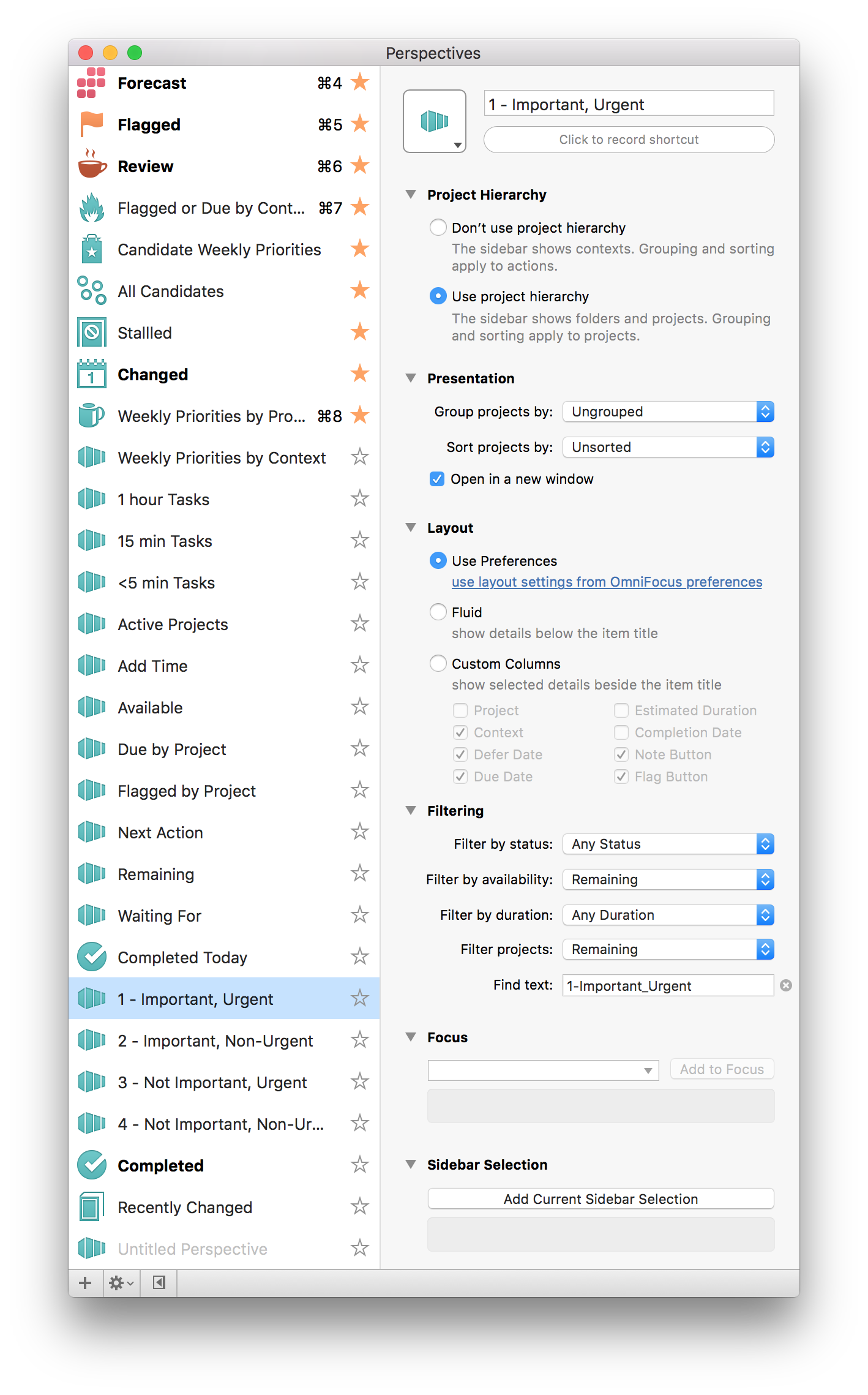
Warp Speed Sound Generator
I grew up reading science fiction. Maybe that's why I find the Warp Speed Sound Generator irresistible.....
Scrivener iOS: From Alpha to Beta
It looks like our long wait may be over. A post on the Literature and Latte blog this week said the iOS version of Scrivener will move from in-house Alpha testing to wider spread Beta testing. From the article, looks like they will choose a small number of primary Beta testers to kick the tires....once the egregious bugs have been found they will move to more wide-spread testing. Regardless, I can hardly wait. Scrivener iOS is going to simplify my writing workflow quite significantly.
Importing Microsoft Word files into Ulysses
I subscribe to the newsletter from Soulmen, the makers of my favorite text / markdown writing app, Ulysses. From the newsletter, I learned it is now possible to import Microsoft Word .docx documents. The article said it was possible from any device, but I could only do it using the instructions for iPhone (not on my Mac).In order to import a Word file, it must be in a folder Ulysses can access. Within Ulysses iOS, choose the group where you’d like your imported document to live. Then at the bottom right of screen, choose ‘import’ and select your file. The Word document is converted to MarkdownXL with your formatting intact.Happy writing!
The World's Most Dangerous Writing App
I’ve read plenty on writing. Most resources suggest, when writing a first draft, you simply write whatever comes to mind—writing the whole first draft in one long stream of conciousness. Yesterday, I read a Wired article about The Most Dangerous Writing App, a web tool to help writers get over writer’s block.The app is simple, if you stop writing for more than 5 seconds, The Most Dangerous Writing App erases ALL your work. Not a few sentences, not a paragraph, but everything you’ve written. Now that’s incentive to keep writing (especially if you’ve chosen a longer writing period of 30 minutes to an hour)!I’m not sure if The Most Dangerous Writing App will help me or frustrate me, but am willing to give it a try. If you decide to try it too, please leave your comments below.
